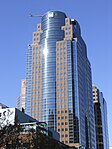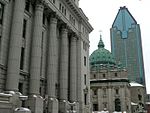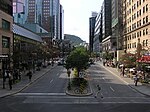Bens De Luxe Delicatessen & Restaurant
1908 establishments in Quebec2006 disestablishments in QuebecAshkenazi Jewish culture in MontrealCommercial buildings completed in 1950Commons link is defined as the pagename ... and 12 more
Defunct restaurants in MontrealDemolished buildings and structures in MontrealDowntown MontrealJewish Canadian historyJewish delicatessens in CanadaJews and Judaism in MontrealLithuanian-Jewish diasporaRestaurants disestablished in 2006Restaurants established in 1908Streamline Moderne architecture in CanadaUkrainian-Jewish diasporaUse mdy dates from November 2014

Bens De Luxe Delicatessen and Restaurant was a renowned delicatessen in Montreal, Canada. The restaurant was famed for its Montreal-style smoked meat sandwich. During its heyday it was a popular late-night dining fixture in the downtown core and a favourite eatery of many celebrities. It was open for nearly a century, from 1908 to 2006. At 98 years it was the oldest deli in the city.
Excerpt from the Wikipedia article Bens De Luxe Delicatessen & Restaurant (License: CC BY-SA 3.0, Authors, Images).Bens De Luxe Delicatessen & Restaurant
Boulevard De Maisonneuve Ouest, Montreal Ville-Marie
Geographical coordinates (GPS) Address Nearby Places Show on map
Geographical coordinates (GPS)
| Latitude | Longitude |
|---|---|
| N 45.502091 ° | E -73.573363 ° |
Address
Boulevard De Maisonneuve Ouest 982
H3A 1T1 Montreal, Ville-Marie
Quebec, Canada
Open on Google Maps









